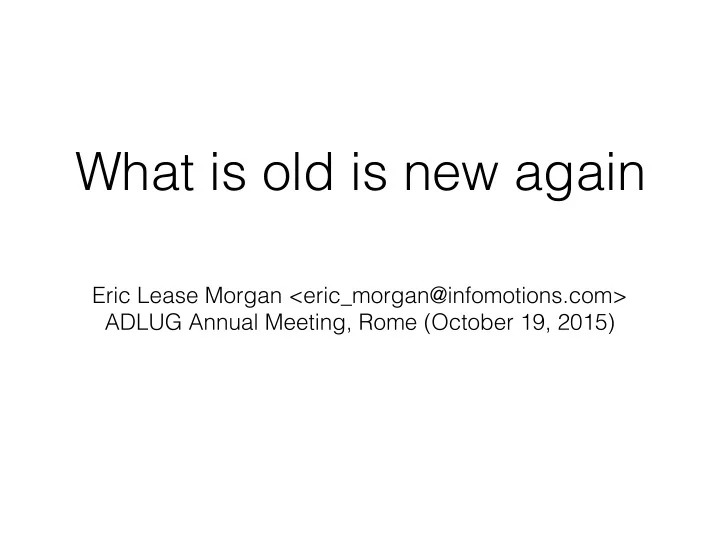

What is old is new again Eric Lease Morgan <eric_morgan@infomotions.com> ADLUG Annual Meeting, Rome (October 19, 2015)
The how’s of librarianship are changing, but not the what’s.
Linked Data Linked Data is a method for describing things. These things can be the objects in a library. Thus, Linked Data can be a type of bibliographic description.
Triples Triples are the basic data structure of Linked Data, and, they are made up of three parts: 1. subjects - URIs pointing to things real or imaginary 2. objects - URIs or literals (words, phrases, or numbers) 3. predicates - URIs denoting relationships between subjects and objects
Triples, continued [ subject ] --- predicate ---> [ object ]
Triples, continued / --- a predicate ---------> [ an object ] [ subject ] - | --- another predicate ---> [ another object ] \ --- a third predicate ---> [ a third object ] | | yet another predicate | | \ / [ yet another object ]
Triples, examples [subject] [predicate] [object] http://example.org/rome http://example.org/name "Rome"
Triples, examples [subjects] [predicates] [objects] http://example.org/rome http://example.org/name "Rome" http://example.org/rome http://example.org/founding-date "1000 BC" http://example.org/rome http://example.org/description "A long long time ago,..” http://example.org/rome http://example.org/type http://example.org/city http://example.org/rome http://example.org/sub-part http://example.org/italy
Triples, examples [http://example.org/rome] | | --- / -- http://example.org/name ----------> ["Rome"] | -- http://example.org/description ---> ["A long time ago…"] | -- http://example.org/founding-date -> ["1000 BC"] | -- http://example.org/sub-part -----> [http://example.org/italy] \ -- http://example.org/type ----------> [http://example.org/city]
Triples, examples [subjects] [predicates] [objects] http://example.org/italy http://example.org/name "Italy" http://example.org/italy http://example.org/founding-date "1923 AD" http://example.org/italy http://example.org/type http://example.org/country http://example.org/italy http://example.org/sub-part http://example.org/europe
Triples, examples [subjects] [predicates] [objects] http://example.org/paris http://example.org/name "Paris" http://example.org/paris http://example.org/founding-date "100 BC" http://example.org/paris http://example.org/description "There's this tower..." http://example.org/paris http://example.org/type http://example.org/city http://example.org/paris http://example.org/sub-part http://example.org/france http://example.org/london http://example.org/name "London" http://example.org/london http://example.org/description "Warm beer is here." http://example.org/london http://example.org/founding-date "100 BC" http://example.org/london http://example.org/type http://example.org/city http://example.org/london http://example.org/sub-part http://example.org/england http://example.org/newyork http://example.org/founding-date "1640 AD" http://example.org/newyork http://example.org/name "New York" http://example.org/newyork http://example.org/description "Never sleeps." http://example.org/newyork http://example.org/type http://example.org/city http://example.org/newyork http://example.org/sub-part http://example.org/usa
Triples, usefulness • What things are denoted as types of cities, and what are their names? • What is the oldest city? • What cities were founded after the year 1 AD? • What countries are sub-parts of Europe? • How would you describe Rome?
Linked Data, why When the content of libraries is manifested as Linked Data, then new relationships between resources will be discovered and uncovered. Linked Data is a newer, more timely method of describing collections; what is old is new again .
Curation of digital objects The curation of collections does not have to be limited to physical objects. With the advent of the Internet there exists an abundance of full-text digital objects just waiting to be harvested, collected, and cached. But it is not good enough to link and point to such objects because links break and institutions (websites) dissolve.
Curation, continued Digital curation is not easy, and it requires systematic organization and evaluation in order to be useful. There are many advantages, including: long-term access, analysis & evaluation, use & re-use, and relationship building. Examples include: institutional repositories, bibliographic indexes, and collections of complete works of interest.
Curation, an example In the recent past I have created “browsers” used to do “distant reading” against curated collections of materials harvested from the HathiTrust, the EEBO-TCP, and JSTOR.
Curation, an example [Demonstrate one or more of the browsers here.]
What is old is new again The traditional principles of librarianship (collection, organization, preservation, and dissemination) are alive and well in this digital age. Such are the what’s of librarianship. It is the how’s of the librarianship that need to evolve in order the profession to remain relevant.
Recommend
More recommend